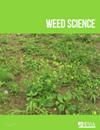伊利诺伊州中部水麻(Amaranthus tuberculatus)种群对s -甲草胺抗性的遗传
IF 2.5
2区 农林科学
Q2 AGRONOMY
引用次数: 0
摘要
摘要水麻苋(Amaranthus tuberculatus, Moq.)Sauer]是一种雌雄异株杂草,通过快速代谢进化出对极长链脂肪酸(VLCFA)延长酶抑制除草剂的抗性。尽管解毒酶活性与伊利诺伊州两个多重除草剂抗性(MHR)结核分枝杆菌群体的S -甲草胺抗性有关,但抗性的遗传基础尚不清楚。因此,我们的目标是调查S -甲草胺抗性在斯坦福,伊利诺斯州抗性(SIR)群体中的遗传。具体来说,我们的研究目标是:i)利用未出现的S -异丙甲草胺,通过3代反复选择产生具有一致抗性的全同胞近自交系(DK - 3-2); ii)通过DK - 3-2的单株(一雄一雌)全同胞交配和VLCFA抑制除草剂敏感群体(SEN),培育出具有S -异丙甲草胺抗性的瘤蚜群体;iii)通过温室剂量反应分析,量化亲本系及其f1后代对S -异丙草胺的抗性水平;iv)评估f2后代对S -异丙草胺抗性的遗传。使用6 ~ 8 S -异甲草胺浓度(0.015 ~ 15.0 μM;对SIR、SEN、DK 3-2和f1后代产生的致死剂量(LD)估计为50% (LD 50)和90% (LD 90)。致死剂量估计表明,DK 3-2对S -异丙甲草胺的抗性高于SIR种群,表明单杂交显著增加了DK 3-2对S -异丙甲草胺的抗性。与父系衍生系相比,f2家族对S -异丙甲草胺的抗性水平处于中等水平(R:S = 3:1),表明父系衍生系对S -异丙甲草胺的抗性符合单基因模型(R:S = 3:1),表明单个显性基因决定了SIR对S -异丙甲草胺的抗性。然而,母系衍生系的f2分离结果符合重复隐性上位模型(R:S = 9:7)。这表明第二个隐性基因也可能修饰SIR对S -异丙甲草胺的抗性。本研究的结果和种质可以帮助鉴定结核分枝杆菌对S -异丙甲草胺的抗性基因。本文章由计算机程序翻译,如有差异,请以英文原文为准。
Inheritance of resistance to S-metolachlor in a waterhemp (Amaranthus tuberculatus) population from central Illinois
Abstract Waterhemp [ Amaranthus tuberculatus (Moq.) Sauer] is a dioecious weed that has evolved resistance to very-long-chain fatty acid (VLCFA) elongase-inhibiting herbicides via rapid metabolism. Although detoxification enzyme activities are associated with S -metolachlor resistance in two multiple herbicide-resistant (MHR) A. tuberculatus populations from Illinois, the genetic basis of resistance is unknown. Therefore, our goal was to investigate inheritance of S -metolachlor resistance in the Stanford, Illinois Resistant (SIR) population. Specifically, our research objectives were to: i) generate a uniformly resistant, full-sib near inbred line (DK 3-2 ) via three generations of recurrent selection for resistance using preemergence S -metolachlor, ii) develop A. tuberculatus populations segregating for S -metolachlor resistance via reciprocal single plant (one male × one female) full-sib mating of DK 3-2 and a VLCFA inhibiting herbicide-sensitive population, SEN, iii) quantify S -metolachlor resistance levels in parental lines and their F 1 progenies via greenhouse dose-response analysis, and iv) evaluate inheritance of S -metolachlor resistance in F 2 progenies. Dose-response analysis using 6 to 8 S -metolachlor concentrations (0.015–15.0 μM; varying per population) generated lethal dose (LD) estimates of 50% (LD 50 ) and 90% (LD 90 ) for SIR, SEN, DK 3-2 and F 1 progenies. Lethal dose estimates indicated DK 3-2 has a higher magnitude of S -metolachlor resistance than the SIR population, demonstrating single crosses significantly increased S -metolachlor resistance in DK 3-2 . Levels of S -metolachlor resistance in F 1 populations were intermediate compared to DK 3-2 and SEN. Segregation of S -metolachlor resistance in F 2 families from the paternal-derived lines fit a single-gene model (R:S = 3:1), indicating a single, dominant gene confers S -metolachlor resistance in SIR. However, F 2 segregation results from the maternal-derived lines fit a duplicate recessive epistasis model (R:S = 9:7), indicating a second recessive gene may also modify S -metolachlor resistance in SIR. Results and germplasm derived from this research can assist in identifying the gene(s) conferring resistance to S -metolachlor in A. tuberculatus .
求助全文
通过发布文献求助,成功后即可免费获取论文全文。
去求助
来源期刊

Weed Science
农林科学-农艺学
CiteScore
4.60
自引率
12.00%
发文量
64
审稿时长
12-24 weeks
期刊介绍:
Weed Science publishes original research and scholarship in the form of peer-reviewed articles focused on fundamental research directly related to all aspects of weed science in agricultural systems. Topics for Weed Science include:
- the biology and ecology of weeds in agricultural, forestry, aquatic, turf, recreational, rights-of-way and other settings, genetics of weeds
- herbicide resistance, chemistry, biochemistry, physiology and molecular action of herbicides and plant growth regulators used to manage undesirable vegetation
- ecology of cropping and other agricultural systems as they relate to weed management
- biological and ecological aspects of weed control tools including biological agents, and herbicide resistant crops
- effect of weed management on soil, air and water.
 求助内容:
求助内容: 应助结果提醒方式:
应助结果提醒方式:


